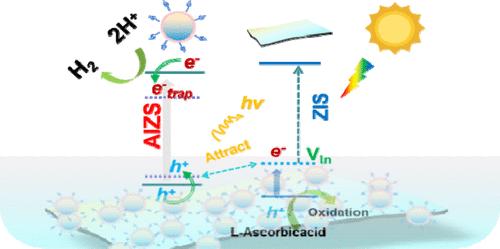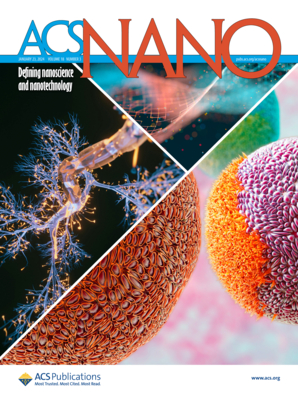High-Density Donor–Acceptor Pair Mediated Carrier Transport Dynamics for Hydrogen Production Performance Promotion Based on Nonstoichiometric Quantum Dots
IF 15.8
1区 材料科学
Q1 CHEMISTRY, MULTIDISCIPLINARY
引用次数: 0
Abstract
Ternary I–III–VI semiconductors are useful light-capture materials, but the presence of a special donor–acceptor pair complicates the dynamics of carriers in the photocatalytic process, and the combined effect of multiple types of defects makes it difficult to study the single type of defect on carrier dynamics. Here, excess inorganic S2– ligand is used to passivate the surface defects of the nonstoichiometric ratio Ag–In–Zn–S quantum dots (QDs), which enables the systematic investigation of the effects of high-density donor–acceptor pairs on the carrier separation and transfer path during photocatalysis. The results show that the donor–acceptor pair defects in quantum dots can effectively separate the carriers because the defects generated by the donor or acceptor can effectively “store” the carriers at the fixed energy level and provide an additional path for the transfer of the carriers. The calculation results of density functional theory are consistent with the characterized structure of FTIR, proving the feasibility of inorganic S2– replacing MPA. The indium vacancy (VIn) in ZIS nanosheets serves as a carrier stored in the donor–acceptor pairs, effectively optimizing the dynamics of the carrier. The h+ in the donor–acceptor pair and the e– on VIn attract each other through the built-in electric field and radiate energy in the form of visible light. Through this strategy, the photocatalytic hydrogen production efficiency of the heterojunction can reach up to 80.7 mmol·g–1·h–1, which is more than 1400 times the overall hydrogen production efficiency of AgInZnS3 and AgInS-ZnS. This work provides some theoretical guidance for the systematic study of the effects of the donor–acceptor pair on charge carrier dynamics.

求助全文
约1分钟内获得全文
求助全文
来源期刊

ACS Nano
工程技术-材料科学:综合
CiteScore
26.00
自引率
4.10%
发文量
1627
审稿时长
1.7 months
期刊介绍:
ACS Nano, published monthly, serves as an international forum for comprehensive articles on nanoscience and nanotechnology research at the intersections of chemistry, biology, materials science, physics, and engineering. The journal fosters communication among scientists in these communities, facilitating collaboration, new research opportunities, and advancements through discoveries. ACS Nano covers synthesis, assembly, characterization, theory, and simulation of nanostructures, nanobiotechnology, nanofabrication, methods and tools for nanoscience and nanotechnology, and self- and directed-assembly. Alongside original research articles, it offers thorough reviews, perspectives on cutting-edge research, and discussions envisioning the future of nanoscience and nanotechnology.
 求助内容:
求助内容: 应助结果提醒方式:
应助结果提醒方式:


